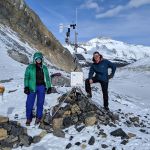Not a member of Pastebin yet?
Sign Up,
it unlocks many cool features!
- Abstract:
- The formation of a proglacial lake may affect the mass loss rate of the upstream glacier and the transport behavior of glacial-derived sediment and water. Investigating the rapidly-changing behavior of proglacial lakes is important for understanding future changes in glacial environments. Tracking changes in proglacial lakes at large scale is impractical by manual methods because of the time-consuming and subjective nature of manual delineation. We investigate the ice-marginal lake delineation capabilities of a family of automated maximum-likelihood classifiers implemented in Google Earth Engine. These algorithms classify the Gulf of Alaska region by generalized land cover type and extract water cover features from the classification map. We determine the effectiveness of each classifier against hand-delineated lake outlines serving as truth maps.
- Histogram analysis suggests image classification utilizing Landsat bands 5, 6, 8, and 10 has the highest potential to distinguish between most land cover types and water in our glacierized study area. Despite the general success of lake delineation using a classifier provided with only these bands, it falsely classifies frequently wet unconsolidated supraglacial debris and deep terrain shadows as water. Compared to these problematic regions, lake surfaces are flatter and more consistent in appearance. To separate uniform lake land cover from textured supraglacial debris, we calculate the windowed standard variation of bands 5, 6, and 8, and include these local variance maps in the classifier input. To separate flat lake surfaces from dark shadows cast by steep terrain, we include a slope map in the classifier input.
- These additions improve classification mean true-positive rate by 161%. Future efforts will combine band thresholding and other approaches with maximum likelihood classification to increase accuracy of water detection. We will temporally aggregate water detections using our previously developed “bubblebath” algorithm to improve lake delineation capability where sediment and ice concentration vary or where cloud and shadow frequently obscure lake area. Refinement of our procedure will allow large-scale scale tracking of proglacial lakes, enabling investigation of how they are changing and altering both upstream and downstream systems.
- Introduction:
- Proglacial lakes are important because
- CO2 sink (St. Pierre et al. 2019)
- Mass loss rate of upstream glacier
- Captures glacial sediment
- Challenges of delineation:
- Non-linear shape of the spectral space? Reference “tasseled cap”.
- “Cluster Busting” (Ozesmi and Bauer 2002) But not found to be any more effective than supervised classification
- Heterogeneity in cryosphere environment (Zhang et al. 2018)
- Mountain shadow confusing (Jiang et al. 2017) Found that mountain shadow reflectance lies between that of mixed and pure water, causing confusion in water indices.
- Spectral similarity between proglacial water and ice due to similar bulk visible/infrared reflective properties (Racoviteanu et al. 2018).
- Methods:
- Buffering RGI (Zhang et. al 2018, Rounce et al. 2017)
- Iterative buffering of lakes (Brown and Young 2006) Too complex to begin implementing in GEE
- Manual refinement (Wang et al. 2014) want to avoid.
- Remove lakes based on linearity (Jiang et al. 2014, Paltan et al. 2015)
- Find lowest color gradient (homogenous surface) (Jiang et al. 2014)
- Broad thresholding identification followed by a texturally-sensitive refinement of the lake boundaries works well (Jiang et al. 2017)
- Combining DEMs with multi-spectral classification (Racoviteanu et al. 2008)
- Temporal analysis:
- Pixel-based through time (Nitze et al.) Calculated statistics describing change in each spectral band for each pixel (30 metrics)
- Lake-based through time
- Challenges include figuring out how changing and poorly-observed lakes are related through time
- Solution/Methodology:
- Choose descriptive training classes with training data from across the region (Alaska Range, Wrangell-St. Elias Mtns, Talkeetna Mtns)
- Select bands of interest based on discriminatory power between water and not-water.
- Produce annual confidence maps based on multiple identifications at different times within the year
- Why? Summer presents challenges because glacial surface is very wet, winter presents challenges because longer shadows.
- Automatically delineate lake images, exploit AKHydro lake delineation to reject false positives.
- Use bubblebath to connect them temporally
- Conclusions:
- TBD
Advertisement
Add Comment
Please, Sign In to add comment

